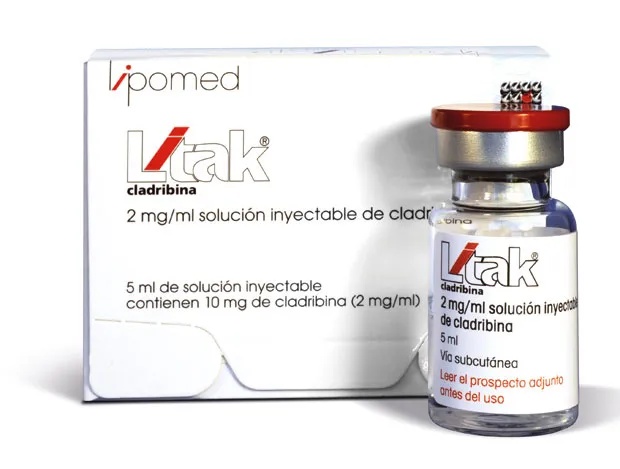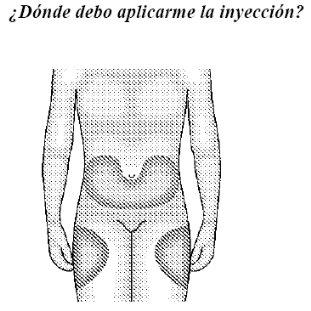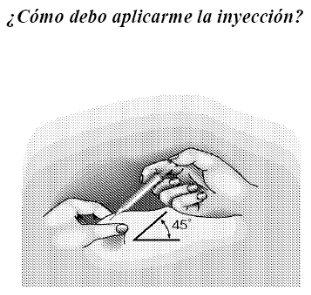
Инструкция по применению ЛИТАК 2 мг/мл ИНЪЕКЦИОННЫЙ РАСТВОР
Введение
ПРОСПЕКТ: ИНФОРМАЦИЯ ДЛЯ ПОЛЬЗОВАТЕЛЯ
ЛИТАК 2 мг/мл раствор для инъекций
кладрибина
Прочитайте внимательно весь листок-вкладыш перед началом использования этого лекарства, поскольку он содержит важную информацию для вас.
- Сохраните этот листок-вкладыш, поскольку вам может понадобиться перечитать его.
- Если у вас есть какие-либо вопросы, проконсультируйтесь с вашим врачом или фармацевтом.
- Если вы испытываете побочные эффекты, проконсультируйтесь с вашим врачом или фармацевтом, даже если это побочные эффекты, которые не указаны в этом листке-вкладыше. См. раздел 4.
Содержание листка-вкладыша:
- Что такое ЛИТАК и для чего он используется
- Что вам нужно знать перед началом использования ЛИТАКА
- Как использовать ЛИТАК
- Возможные побочные эффекты
- Хранение ЛИТАКА
- Состав упаковки и дополнительная информация
1. Что такое литак и для чего он используется
ЛИТАК содержит активное вещество кладрибину. Кладрибина является цитостатиком, который влияет на рост злокачественных белых кровяных клеток (лейкемии), которые играют важную роль в развитии волосатой лейкемии (триколейкемии). ЛИТАК используется для лечения этого заболевания
2. Что вам нужно знать перед началом использования ЛИТАКА
Не используйте ЛИТАК
- Если вы аллергичны к кладрибине или к любому другому компоненту ЛИТАКА (перечисленному в разделе 6).
- Если вы беременны или кормите грудью.
- Если вам меньше 18 лет.
- Если у вас есть умеренная или тяжелая почечная или печеночная недостаточность.
- Если вы принимаете другие лекарства, которые влияют на производство кровяных клеток в костном мозге (миелосупрессия).
Предостережения и меры предосторожности
Проконсультируйтесь с вашим врачом или фармацевтом перед началом использования ЛИТАКА.
В любое время во время или после лечения немедленно сообщитевашему врачу или медсестре, если у вас出现ятся следующие симптомы или признаки: размытое зрение, потеря зрения или двойное зрение, трудности с речью, слабость в руке или ноге, изменение походки или проблемы с равновесием, онемение, снижение чувствительности или потеря чувствительности, потеря памяти или спутанность сознания. Все эти симптомы могут быть признаками тяжелого и потенциально смертельного заболевания мозга, известного как лейкоэнцефалопатия.
Если у вас были эти симптомы до начала лечения кладрибиной, сообщитевашему врачу, если вы заметите какие-либо изменения в этих симптомах.
Сообщите вашему врачу, если у вас есть или были:
- Проблемы с почками или печенью.
- Инфекции
- Если вы заразились, инфекция должна быть вылечена до начала использования ЛИТАКА.
- Если вы заметите какие-либо признаки инфекции (например, симптомы гриппа или лихорадка) во время или после лечения ЛИТАКА, немедленно сообщите вашему врачу.
- Лихорадка.
До начала лечения ЛИТАКА и во время него у вас будут проводиться регулярные анализы крови, чтобы проверить, можете ли вы продолжать лечение без опасности. Ваш врач может решить, что вам необходимо переливание крови, чтобы улучшить количество кровяных клеток. Кроме того, будет проверено, функционируют ли печень и почки правильно.
Мужчины, которые хотят иметь детей, должны предупредить своего врача перед началом лечения ЛИТАКА. Не следует зачинаать детей во время лечения и до шести месяцев после окончания лечения ЛИТАКА. Ваш врач может посоветовать вам о возможности сохранения спермы (криоконсервации).
Другие лекарства и ЛИТАК
Сообщите вашему врачу, если вы принимаете или недавно принимали другие лекарства, включая те, которые можно купить без рецепта. В частности, сообщите вашему врачу, если вы принимаете любое лекарство, содержащее:
- Кортикостероиды, часто используемые для лечения воспаления.
- Антивирусные препараты, используемые для лечения вирусных инфекций.
НЕ следует использовать ЛИТАК с другими лекарствами, которые влияют на производство кровяных клеток в костном мозге (миелосупрессия).
Беременность и лактация
Не следует использовать ЛИТАК, если вы беременны. Вам необходимо принимать меры предосторожности во время лечения и как минимум шесть месяцев после последней дозы ЛИТАКА. Если вы забеременеете во время лечения, немедленно сообщите вашему врачу.
Не следует кормить грудью во время лечения ЛИТАКА и как минимум шесть месяцев после последней дозы ЛИТАКА.
Вождение и использование машин
Влияние ЛИТАКА на способность управлять транспортными средствами и работать с машинами является важным. Если вы чувствуете сонливость, которая может возникнуть из-за низкого количества красных кровяных клеток, вызванного лечением ЛИТАКА, или головокружение, не следует управлять транспортными средствами или работать с машинами.
3. Как использовать ЛИТАК
Всегда следуйте инструкциям по применению ЛИТАКА, указанным вашим врачом. Если у вас есть сомнения, проконсультируйтесь с вашим врачом или фармацевтом.
Ваш врач рассчитает дозу, которую вам необходимо принять, на основе вашего веса и подробно объяснит график лечения. Рекомендуемая суточная доза составляет 0,14 мг на килограмм веса, в течение пяти последовательных дней (один цикл лечения).
ЛИТАК должен быть введен под кожу (подкожная инъекция), примерно в одно и то же время каждый день. Если вы сами вводите ЛИТАК, вы должны получить соответствующую подготовку от вашего врача или медсестры. Вы найдете подробные инструкции для инъекции в конце этого листка-вкладыша.
Вам также может быть назначен дополнительный препарат, содержащий активное вещество алопуринол, для снижения избыточной мочевой кислоты.
Если вы примете больше ЛИТАКА, чем необходимо
В случае введения неправильной дозы немедленно сообщите вашему врачу.
Если вы забыли использовать ЛИТАК
Не вводите двойную дозу, чтобы компенсировать пропущенные дозы. Если вы забыли ввести дозу, немедленно сообщите вашему врачу.
Если у вас есть какие-либо другие вопросы о использовании этого продукта, проконсультируйтесь с вашим врачом или фармацевтом.
4. Возможные побочные эффекты
Как и все лекарства, ЛИТАК может вызывать побочные эффекты, хотя не все люди испытывают их.
Немедленно сообщите вашему врачу, если у вас появляются какие-либо из следующих симптомов или признаков во время или после лечения ЛИТАКА:
- Любой признак инфекции (например, симптомы гриппа).
- Лихорадка.
Не можно исключить повторное возникновение злокачественного заболевания (рака). Это означает, что риск развития злокачественного новообразования в будущем немного выше, чем у здоровых людей. Этот немного повышенный риск может быть вызван самой волосатой лейкемией или лечением, использованным для лечения заболевания, включая ЛИТАК.
Могут возникнуть следующие побочные эффекты:
Очень частые побочные эффекты (могут возникнуть у более 1 из 10 пациентов)
- Инфекции.
- Лихорадка.
- Низкое количество определенных белых кровяных клеток (нейтрофилов и лимфоцитов) и тромбоцитов в анализах крови.
- Низкое количество красных кровяных клеток, что может вызвать анемию, с симптомами, такими как усталость и сонливость.
- Снижение функции иммунной системы организма.
- Головная боль, головокружение.
- Аномальные дыхательные звуки, аномальные звуки в груди, кашель.
- Тошнота, рвота, запор и диарея.
- Кожная сыпь, отек, покраснение и боль в месте инъекции, потоотделение.
Кожные реакции в основном легкие или умеренные и обычно разрешаются в течение нескольких дней.
- Усталость, озноб, снижение аппетита.
- Слабость.
Частые побочные эффекты (могут возникнуть у до 1 из 10 пациентов)
- Повторное возникновение злокачественного новообразования (рака).
- Низкое количество тромбоцитов, что может вызвать необычное кровотечение (например, носовые или кожные кровотечения).
- Сонливость, тревога.
- Ускорение сердечного ритма, аномальные сердечные звуки, низкое кровяное давление, снижение кровотока к сердечной мышце.
- Трудности с дыханием, отек легких из-за инфекции, воспаление рта и языка.
- Боль в животе при наличии избыточного газа в желудке или кишечнике, в основном легкие увеличения показателей анализов печени (билирубина, трансаминаз), которые вернутся к норме после окончания лечения.
- Кожная сыпь с зудом (уртикария), покраснение кожи и боль в коже.
- Отек тканей (эдема), дискомфорт, боль (мышечная боль, боль в суставах и боль в костях).
Редкие побочные эффекты (могут возникнуть у до 1 из 100 пациентов)
- Анемия, вызванная разрушением красных кровяных клеток.
- Сонливость, онемение и покалывание кожи, слабость, бездействие, периферическая невропатия, спутанность сознания, нарушение координации движений.
- Воспаление глаз.
- Боль в горле.
- Воспаление вены.
- Сильная потеря веса.
Очень редкие побочные эффекты (могут возникнуть у до 1 из 1 000 пациентов)
- Снижение функции печени.
- Снижение функции почек.
- Осложнения, вызванные лечением рака, из-за разрушения раковых клеток.
- Реакция на переливание крови.
- Увеличение количества определенных белых кровяных клеток (эозинофилов).
- Инсульт.
- Нарушения речи и глотания.
- Сердечная недостаточность.
- Нарушения сердечного ритма.
- Неспособность сердца поддерживать адекватный кровоток.
- Закупорка кишечника.
- Тяжелая аллергическая кожная реакция (синдром Стивенса-Джонсона или синдром Лайелла).
Очень редкие побочные эффекты (могут возникнуть у до 1 из 10 000 пациентов)
- Депрессия, эпилептический приступ.
- Отек век.
- Тромб в легких.
- Воспаление желчного пузыря.
- Снижение функции органов из-за высокого уровня определенного вещества, производимого организмом (глюкопротеина).
Сообщение о побочных эффектах
Если вы испытываете любой побочный эффект, проконсультируйтесь с вашим врачом или фармацевтом, даже если это возможные побочные эффекты, которые не указаны в этом листке-вкладыше. Вы также можете сообщить о них напрямую через национальную систему уведомления, включенную в Приложение V. Сообщая о побочных эффектах, вы можете внести свой вклад в предоставление более подробной информации о безопасности этого лекарства.
5. Хранение ЛИТАКА
Хранить в недоступном для детей месте.
Хранить в холодильнике (при температуре между 2 °C и 8 °C). Не замораживать.
Не используйте ЛИТАК после даты истечения срока годности, указанной на этикетке ампулы и на внешней упаковке после «Срок годности». Срок годности - последний день месяца, указанного.
С микробиологической точки зрения, если открытие продукта не исключает риск микробного загрязнения, продукт должен быть использован немедленно. Если он не используется немедленно, сроки и условия хранения при использовании являются ответственностью пользователя.
Не используйте ЛИТАК, если ампула повреждена или если раствор не прозрачный или содержит частицы.
Утилизация неиспользованного лекарства и всех материалов, которые были в контакте с ним, должна быть осуществлена в соответствии с местными правилами.
6. Состав упаковки и дополнительная информация
Состав ЛИТАКА
- Активное вещество - кладрибина. Каждый миллилитр раствора содержит 2 мг кладрибины. Каждая ампула содержит 10 мг кладрибины в 5 мл раствора.
- Другие компоненты - хлорид натрия, гидроксид натрия (для регулирования pH), соляная кислота (для регулирования pH) и вода для инъекций.
Внешний вид продукта и состав упаковки
ЛИТАК выпускается в ампулах из стекла, содержащих 5 мл прозрачного и бесцветного раствора для инъекций.
Упаковка по 1 или 5 ампул. Возможно, не все размеры упаковок будут выпускаться.
Владелец разрешения на маркетинг и производитель
Lipomed GmbH
Хегенхаймерштрассе 2
Д-79576 Вайль/Рейн
Германия
Вы можете запросить дополнительную информацию о этом лекарстве, обратившись к владельцу разрешения на маркетинг.
Дата последнего обновления этого листка-вкладыша:
Подробная информация о этом лекарстве доступна на сайте Европейского агентства по лекарствам: http://www.ema.europa.eu.
ИНСТРУКЦИИ ДЛЯ ИНЪЕКЦИИ
Этот раздел содержит информацию о том, как вводить инъекцию ЛИТАКА. Важно, чтобы вы не пытались вводить инъекцию самостоятельно, если только ваш врач или медсестра не даст вам соответствующие инструкции. Ваш врач скажет вам, какое количество ЛИТАКА вам необходимо и когда вы должны вводить его самостоятельно. ЛИТАК должен быть введен под кожу (подкожная инъекция). Если у вас есть вопросы о введении инъекции, обратитесь к вашему врачу или медсестре.
ЛИТАК является цитотоксичным и, поэтому, должен быть обращен с осторожностью. Когда пациент не вводит ЛИТАК самостоятельно, рекомендуется использовать одноразовые перчатки и защитные очки при обращении и введении ЛИТАКА. Если ЛИТАК попадет на кожу или глаза, немедленно промойте пораженную область большим количеством воды. Беременные женщины должны избегать контакта с ЛИТАКА.
Что мне нужно для инъекции?
Для самостоятельного введения подкожной инъекции вам понадобится:
- Ампула ЛИТАКА (или две ампулы, если необходимо ввести более 5 мл).
Не используйте ампулы, если они повреждены или если раствор не прозрачный или содержит частицы.
- Стерильная шприц (например, шприц LUER 10 мл).
- Стерильная игла для инъекции (например, 0,5 x 19 мм, 25 G x ¾ дюйма).
- Марля/ватный тампон, смоченный в спирте.
- Контейнер, устойчивый к проколам, для безопасной утилизации использованных шприцев.
Что мне нужно сделать перед инъекцией ЛИТАКА?
- Перед инъекцией оставьте ампулу ЛИТАКА при комнатной температуре.
- Тщательно вымойте руки.
- Найдите удобное и хорошо освещенное место и положите все необходимое рядом.
Как подготовить инъекцию?
Перед инъекцией ЛИТАКА вам необходимо:
- Снять защитную крышку с ампулы ЛИТАКА. Не вынимайте пробку из ампулы. Протрите пробку марлей, смоченной в спирте. Выньте шприц из упаковки, не трогая носик. Выньте иглу для инъекции из упаковки и вставьте ее плотно в носик шприца. Снимите защитный чехол с иглы, не трогая иглу.
- Вставьте иглу через пробку ампулы и переверните ампулу и шприц. Убедитесь, что кончик иглы находится в растворе.
- Втяните точно необходимое количество ЛИТАКА в шприц, оттянув поршень (ваш врач скажет вам, сколько мл ЛИТАКА необходимо ввести).
- Выньте иглу из ампулы.
- Убедитесь, что в шприце нет воздуха: поднимите иглу и выпустите воздух.
- Проверьте, что объем раствора в шприце правильный.
- Введение раствора должно быть осуществлено немедленно.
| На этом рисунке указаны наиболее удобные места для инъекции: верхняя часть бедер и живот, за исключением области вокруг пупка. Если кто-то другой вводит вам инъекцию, также можно сделать это на внешней стороне рук или на ягодицах. |
|
|
- Легко оттяните поршень, чтобы убедиться, что не попали в кровеносный сосуд. Если вы видите кровь в шприце, выньте иглу и вставьте ее в другое место.
- Введение раствора должно быть осуществлено медленно и равномерно в течение примерно 1 минуты, постоянно держа кожу между пальцами.
- После введения раствора выньте иглу.
- Бросьте использованный шприц в контейнер, устойчивый к проколам. Используйте новый шприц и иглу для каждой инъекции. Ампулы предназначены для одноразового использования. Верните открытые ампулы с оставшимся нераспределенным раствором вашему врачу или фармацевту для правильной утилизации.
Утилизация использованных шприцев
Бросьте использованные шприцы в контейнер, устойчивый к проколам, и храните его вне досягаемости и поля зрения детей.
Утилизируйте контейнер, устойчивый к проколам, согласно инструкциям вашего врача, медсестры или фармацевта.
Не бросайте использованные шприцы в домашний мусор.
- Страна регистрации
- Активное вещество
- Требуется рецептДа
- Производитель
- Информация носит справочный характер и не является медицинской рекомендацией. Перед приемом любых препаратов проконсультируйтесь с врачом. Oladoctor не несет ответственности за медицинские решения, принятые на основе этого контента.
- Аналоги ЛИТАК 2 мг/мл ИНЪЕКЦИОННЫЙ РАСТВОРФорма выпуска: ИНЪЕКЦИОННЫЙ РАСТВОР, 10 мг кладрибина / 10 млАктивное вещество: КладрибинПроизводитель: Atnahs Pharma Netherlands Bv.Требуется рецептАктивное вещество: КладрибинПроизводитель: Lipomed GmbhТребуется рецептФорма выпуска: ИНЪЕКЦИОННЫЙ РАСТВОР ДЛЯ ИНФУЗИЙ, 250 мгАктивное вещество: НеларабинПроизводитель: Sandoz Pharmaceuticals D.D.Требуется рецепт
Аналоги ЛИТАК 2 мг/мл ИНЪЕКЦИОННЫЙ РАСТВОР в других странах
Лучшие аналоги с тем же действующим веществом и терапевтическим эффектом.
Аналог ЛИТАК 2 мг/мл ИНЪЕКЦИОННЫЙ РАСТВОР в Польша
Аналог ЛИТАК 2 мг/мл ИНЪЕКЦИОННЫЙ РАСТВОР в Украина
Врачи онлайн по ЛИТАК 2 мг/мл ИНЪЕКЦИОННЫЙ РАСТВОР
Консультация по дозировке, побочным эффектам, взаимодействиям, противопоказаниям и продлению рецепта на ЛИТАК 2 мг/мл ИНЪЕКЦИОННЫЙ РАСТВОР – по решению врача и с учетом местных правил.









